#Solar panels and home value
Explore tagged Tumblr posts
Text
How Solar Panels Can Increase Your Home’s Value
Discover how solar panels boost home value, cut energy bills, and attract eco-conscious buyers. Learn why solar is a smart investment for homeowners today!

Investing in solar panels is not only a step toward sustainable living and lower energy bills, but it can also significantly increase your home’s value. As homebuyers become more environmentally conscious and energy costs continue to rise, properties with solar energy systems are in high demand. Here’s how installing solar panels can boost your property’s worth and make it a more attractive option for potential buyers.

#solar panels#solarcompany#solar rooftop company#solar system#solar energy#solar#solar power#Homebuyers prefer solar homes#Renewable energy and property worth#Eco-friendly home improvements#Solar panels resale value#Energy-efficient home upgrades#Real estate value and solar power#Benefits of solar panels for homeowners#Solar energy investment#Increase property value with solar#Solar panels and home value
1 note
·
View note
Text
How Solar Panels Increase Property Value: The Benefits of Solar-Powered Homes
With the world continuing to embrace sustainable living, more homeowners are switching to solar panels to power their homes. While the environmental benefits of solar energy are well-known, one major factor that’s becoming increasingly evident is how solar panels increase property value. If you’re considering adding solar panels to your home, you’re not only investing in clean energy but also enhancing the long-term value of your property.
In this blog, we’ll explore how solar-powered homes can boost your home resale value with solar and why it’s a smart financial move for any homeowner.
The Rising Demand for Solar-Powered Homes
In recent years, there has been a significant shift in how homebuyers view sustainability and energy efficiency. More people are becoming conscious of their environmental impact and are looking for homes that align with their values. As a result, solar-powered homes are in high demand, and this demand is translating into higher property values.
When you install solar panels on your property, you’re not just reducing your electricity bills; you’re also appealing to the growing number of environmentally-conscious buyers who are actively seeking homes that offer energy efficiency and sustainability. This demand is driving up the market value of homes with solar panels.
How Solar Panels Increase Property Value
1. Lower Energy Bills Attract Buyers
One of the biggest advantages of installing solar panels is the significant reduction in energy costs. Homebuyers are always looking for ways to save money, especially when it comes to utility bills. A solar-powered home offers a major selling point: lower electricity bills.
Solar panels can reduce energy bills by up to 70% or more in many cases. For potential buyers, this means they won’t have to worry about rising energy costs, which can be a major incentive. Research indicates that homes with solar panels fetch higher prices due to the long-term savings they provide. Buyers are often willing to pay more for homes that offer both immediate savings and future cost benefits.
2. A Sustainable Investment
We are living in times where energy efficiency is no longer just a trend—it’s a necessity. Solar-powered homes are seen as a sustainable investment because they reduce the home’s carbon footprint. Many buyers are now prioritizing eco-friendly homes that help them contribute to a greener planet.
By installing solar panels, you’re positioning your home as a future-proof investment. As more people look for ways to reduce their impact on the environment, homes with solar panels are increasingly being viewed as more valuable. The shift toward sustainability is also supported by government incentives and tax rebates for solar energy systems, which further enhance the value of a solar-powered property.
3. Increased Home Resale Value with Solar
When it comes to selling your home, home resale value with solar can be significantly higher. Multiple studies have shown that homes with solar panels typically sell for more than homes without them. According to the U.S. Department of Energy, homes with solar panels usually sell for about 4% more than those without, thanks to the added value of energy savings. This increase in property value is not just because of the reduced energy bills, but also because solar panels are seen as a valuable, long-term asset. Buyers are willing to pay a premium for homes that are equipped with solar panels, as they know they’ll save money on energy costs over time.
4. Faster Home Sales
When buyers are considering homes, the one with solar panels also tend to sell faster than those without them. In today’s competitive real estate market, sellers are looking for ways to stand out from the crowd. By investing in solar energy, you’re giving your property a unique selling point that sets it apart from other homes on the market.
Buyers are increasingly interested in homes that offer energy efficiency, so a solar-powered home can make your property more attractive and increase the chances of a quick sale. The added value and energy savings will make it a more appealing choice for buyers who are looking to reduce their long-term living expenses.
5. Long-Term Financial Benefits
Although the upfront cost of installing solar panels may appear significant, the long-term financial advantages are clear. Over time, the reduction in electricity bills can lead to substantial savings, making it a valuable investment. In fact, many homeowners start seeing a return on investment (ROI) within just a few years of installation. This financial benefit can significantly increase your home’s value. A potential buyer will see that the property offers a solid return on investment in the form of reduced energy costs and long-term savings. The fact that solar panels can last for 25 years or more only adds to the property’s appeal, as buyers know they won’t have to worry about replacing them anytime soon.
6. Appealing to the Next Generation of Homebuyers
Millennials and Gen Z are becoming the dominant groups in the home-buying market, and these generations are particularly focused on sustainability and energy efficiency. These buyers are more likely to prioritize homes with solar panels because they align with their values and commitment to the environment.
As the demand for eco-friendly homes continues to rise, installing solar panels can help future-proof your property and make it more attractive to younger homebuyers. If you’re looking to sell your home in the coming years, having solar-powered homes will likely make it more marketable and appealing to this growing demographic.
7. Government Incentives and Rebates
The government is also offering incentives and rebates to encourage homeowners to invest in solar energy. These incentives help offset the initial cost of installing solar panels, making it more affordable and attractive for homeowners. As the demand for solar energy increases, government programs are expected to continue supporting solar adoption, further boosting property values for homes with solar panels.
In some regions, you may also qualify for tax credits and rebates, which can reduce the cost of installation by a significant amount. These savings can be passed on to potential buyers, making the home even more appealing and increasing its resale value.
Conclusion
Adding solar panels to your home isn’t just good for the environment—it’s also a wise financial move. With the growing demand for solar-powered homes, you’re not only reducing your energy bills and contributing to a sustainable future but also increasing your home resale value with solar.By investing in solar panels, you’re making your home more attractive to potential buyers who are looking for energy-efficient, sustainable living options. So, if you’re looking to add value to your home while doing your part for the environment, now is the perfect time to invest in solar panels.
#solar panels#renewable energy#solar power#solar energy#solar energy in india#solar-powered homes#home resale value with solar#solar-powered home
1 note
·
View note
Text
Do Solar Panels Increase Home Value?
Discover how solar panels can boost your property's value. Learn about the financial and environmental benefits of installing solar panels on your home in this comprehensive guide from LiveZeno.
#Solar Panels Increase Home Value#Residential Solar Panels#Solar Panels in Edmonton#Solar Panel#Solar Installation services#solar panel system#solar panels in Canada#sola panel installation
0 notes
Text
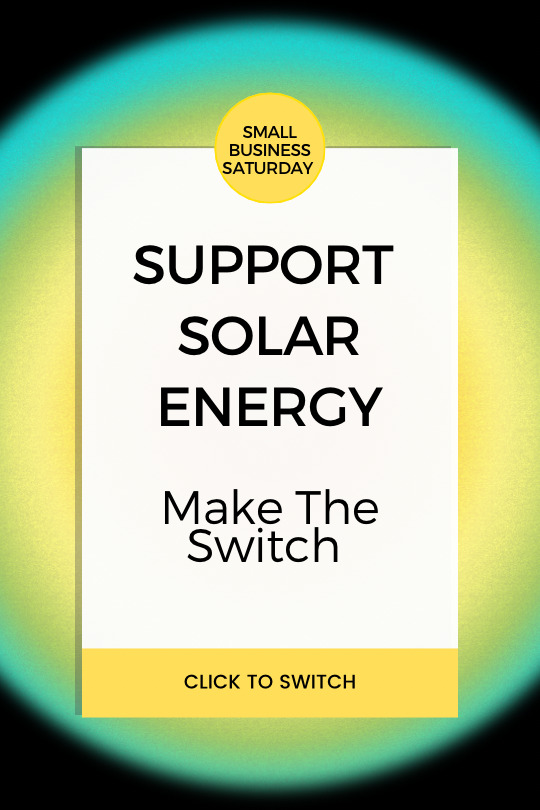
It’s Small Business Saturday and you can support a small business owner who’s goal is to spread awareness and benefits about solar energy. If you’re ready to change your home’s energy source or find out how you can qualify for tax breaks CLICK TO SWITCH.
#small business saturday#solar energy#solar power#solar panels#solar installers near me#lifestyle#nature#sustainability#renewableenergy#renewable power#home value
0 notes
Text
Dandelion News - May 1-7
Like these weekly compilations? Tip me at $kaybarr1735 or check out my Dandelion Doodles!
1. Massive marine sanctuary the size of Yosemite created in the South Atlantic Ocean

“Patagonia Azul Provincial Park aims to protect one of the most biodiverse areas of the South Atlantic, home to whales, sea lions and over 50 species of seabirds. […] The new park draws a protective blue line around over 60 islands and islets, kelp forests and rugged coastal habitats. […] Plans are already underway to build trails, campsites, a biological station and marine access points, making it easier for people to connect with the sea and its incredible wildlife.”
2. Farmers are making bank harvesting a new crop: Solar energy
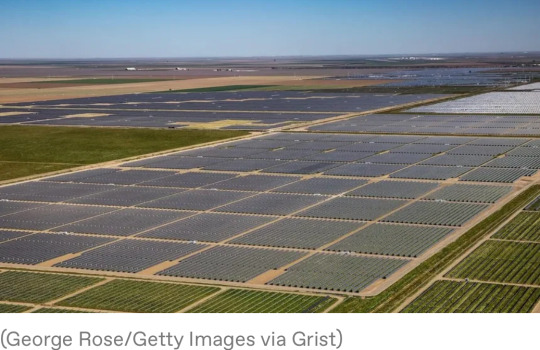
“[… G]rowers are fallowing acreage and installing solar panels. Some are even growing crops beneath them, which is great for plants stressed by too many rays. Still others are letting that shaded land go wild, providing habitat for pollinators and fodder for grazing livestock. […] On average, that energy savings and revenue added up to $124,000 per hectare (about 2.5 acres) each year, 25 times the value of using the land to grow crops.”
3. Maine Gov. Janet Mills beats Donald Trump, gets school meal funds restored while defending trans kids

“The Trump administration has backed down after a federal court intervened in its attempt to cut off funding for Maine’s school meal programs—punishment for the state’s refusal to discriminate against transgender people by barring trans girls from participating in girls’ sports. [… “W]e are pleased that the lawsuit has now been resolved and that Maine will continue to receive funds as directed by Congress to feed children and vulnerable adults.””
4. "It gives some hope": new population of near-extinct tiny chameleons discovered in Madagascar

“[T]he Belalanda chameleon [… has] one of the smallest known distributions of any land vertebrate[…. T]he team discovered two males and one female Belalanda chameleon at the new location, around five kilometres outside of its usual range in the Belalanda area. […] Work’s now underway to help locate and protect any remaining individuals, harnessing the local knowledge of surrounding communities, with hopes of bolstering efforts to safeguard its habitat.”
5. State’s “largest urban solar farm” and battery switches on to help power university

“[… T]he 2.9MW solar farm and 2.5 MW/4.5 MWh battery system is expected to cut the University’s total energy emissions by a further 15 per cent, taking overall emissions reduction at the Bundoora campus to over 65 per cent [since 2019…. T]he new Bundoora solar farm and battery is connected to the grid, meaning that La Trobe will be able to provide support to the grid when required in emergencies to help avoid power issues in the local community.”
April 22-28 news here | (all credit for images and written material can be found at the source linked; I don’t claim credit for anything but curating.)
#hopepunk#good news#nature#biodiversity#nature preserve#conservation#whale#seal#sea birds#farming#farm#solar panels#solar energy#solar power#cleanenergy#donald trump#trump#us politics#school lunch#trans rights#transgender#trans#maine#madagascar#chameleon#endangered species#endangered#habitat#australia#photovoltaic
148 notes
·
View notes
Text
by Seth Mandel
Electricity has been one of the main challenges in Gaza, because Hamas refuses to do the one thing that would solve the problem almost overnight: stop its forever war against Israel. Now, it’s possible that HTS is planning to launch semiannual wars against Jordan and sabotage its own power supply, but I consider the possibility unlikely. That is, however, what Hamas does daily.
Here’s how the electricity in Gaza works. Israel provides 50 percent of the enclave’s power���and I do mean “provides.” Technically, Israel is selling electricity to Gaza, and the Palestinian Authority is supposed to pick up the tab. But they very often don’t, and certainly Hamas doesn’t pay, and every so often Israel threatens to cut off electricity for lack of payment—the debt is usually somewhere in the neighborhood of half a billion dollars. But Israel always backs down or accepts low partial payments.
How much does Hamas value that electricity? Well, it is not uncommon for their own rockets to hit the power lines and cut off parts of the grid. Usually, Israel just fixes the lines when Hamas destroys them. (Israel is terrible at doing genocide.) But on Oct. 7, 2023, Hamas knocked down more than half of their own power lines and Israel did not fix them; it had, if you remember, a few other priorities.
The other half of Gaza’s electricity is split into two main categories: 25 percent comes from Gaza’s diesel-run power plant and the other 25 percent comes from the sun. Gaza has a high concentration of solar cells, because there are lots and lots of roofs and lots of sun. Some of the solar power comes from Israeli companies, much of it from EU and UN projects (meaning, in part, the American taxpayer).
Some Gazans with solar-power systems sell electricity to their neighbors. Some who have their own diesel generators do the same. And the hospitals have been known to set up diesel generators in their bottom floors for public use.
What this means is that about a quarter of Gazan power doesn’t, in general, require the main grid. There’s a problem, however: in addition to Hamas and Palestinian Islamic Jihad rockets knocking down power lines, the fact that these groups operate from private homes means that the return fire from Israel knocks out solar roof panels. Hamas fires from civilian homes with the intent of getting those civilians killed, but doing so also kills the lights. Hamas is indescribably evil.
123 notes
·
View notes
Text
Everyone is all up in arms about what kind of energy source will power the cities of tomorrow. Is it natural gas, the invisible menace that leaks out of shitty welds? Could it be nuclear energy, the thing that makes cool-looking cooling towers and rocks you're not allowed to touch? Or could it be simply harnessing the power of the sun and sticking them into a bank of batteries?
If you ask my local recycling depot, which is stuffed to the absolute gills with scrapped solar panels, the answer is "however many of these things you can carry." And since the power had been cut off at my place ever since my landlord didn't come back from that vacation, it's my answer, too.
Solar companies have been going out of business in my area, claiming that there are unforeseen problems to be solved in the "actually installing solar panels on customer homes" challenge. The venture capitalists who control them have basically decided that any obstacle at all is too many obstacles, and shut the companies down rather than spend five minutes trying to think of a solution, as you do when you have no useful value to society.
It didn't take me long to put these things on top of my house. Turns out that the bolts you need to mount them with are basically the same as the ones I'd been smuggling out of the Pick N Pull in my pockets for the last few years. Something new called "met-ric." A couple spritzes of shoplifted Windex later to clean up the cells, and we were making enough electricity to cook any squirrel that was stupid enough to climb onto my roof.
At first, everything was going great. I could now microwave burritos, and probably other kinds of things if you labour under the pointless delusion that there are any other things to eat that are better than a burrito. Then the sun went down, because it was night. Now having been cruelly denied the thing I only just recently became accustomed to, I began to freak out.
That's when it hit me. Batteries were the answer. Energy storage.
Thanks to the local Wal-Mart and their incredibly lax loss-prevention department, I now have electricity 24 hours a day. All I had to do was shoplift enough flashlights, AA batteries, and duct tape to make it through the night. Sure, it's a pain crawling up there every evening to tape the flashlights onto the panels and make sure they have fresh batteries, but to be honest I would be up here every night trying to knock all the charred wildlife off the wires anyway. Don't you rodent bastards know that I'm trying to save the environment up here?
271 notes
·
View notes
Text

Dusty Skies in California Farm Country
California’s Central Valley is a behemoth of U.S. agriculture. Its farmers grow one-third of the nation’s vegetables and three-quarters of its fruits and nuts, including 400 different commodity crops that represent tens of billions of dollars in value.
However, the amount of land in production fluctuates significantly year to year, with growers leaving some land idle, or fallow, depending on weather, market, and groundwater conditions. In the Central Valley, the amount of fallow land varies by thousands of acres per year, often based on the availability of water for irrigation. Such shifts have implications not just for farmers but for everybody living in the region, new research shows.
In Communications Earth & Environment, scientists detailed a link between fallow farmland and dust storms, showing that idled farmland was the dominant source of human-caused dust storms in California’s Central Valley region between 2008 and 2022.
Dust storms contribute to the accumulation of PM2.5 and PM10—classes of particulate air pollution that are associated with a variety of respiratory and cardiovascular health risks. The particles may also help spread pathogens, including viruses and fungal diseases. Severe dust storms can also lead to near blackout conditions that reduce visibility and make traffic accidents more likely.
“Our findings represent real-world health effects for people in the region, many of whom are farmworkers and spend large amounts of time outside,” said Adeyemi Adebiyi, an assistant professor at the University of California, Merced (UC Merced).
The researchers reported that 88 percent of major human-caused dust events were associated with fallow land. They also found significant increases in both fallow land and dust storms over the study period, which coincided with drought and new limits on how much groundwater can be drawn from ailing aquifers.
On October 11, 2021, the MODIS (Moderate Resolution Imaging Spectroradiometer) on NASA’s Terra satellite captured an image of one of the many dust storms that have affected the region. Dust streamed southeast across the Central Valley, passing through the Tulare Lake Basin, a dried lake home to increasing numbers of fallow fields in recent years. The flood-prone basin has gray clay soils and large numbers of tomato, nut, cotton, and dairy farms.
The OLI (Operational Land Imager) on Landsat 8 captured an image below showing examples of fallow fields in the basin. Fallow fields appear gray or brown compared to irrigated green fields nearb

Previous research has documented increases in dustiness in California, but the reasons for the change were not clear. Atmospheric scientists have also studied the relationship between fallow land and dust storms at individual farms or communities, Adebiyi noted. “But our study is the first we know of where a research team has looked at California as a whole and identified a connection between dust storms and fallow land,” Adebiyi said.
The research is based on data from several satellite and ground-based observation networks of dust, as well as the U.S. Department of Agriculture’s Cropland Data Layer. The dust observations were primarily captured by the MODIS on NASA’s Aqua satellite.
Joshua Viers, a UC Merced agriculture water use expert who was not involved in the study, says there are options for farmers who want to limit dust emissions from fallow fields and find alternatives to crops that require large amounts of water. “There’s been a push toward ‘multi-benefit land repurposing’ as farmers look for ways to achieve sustainable groundwater use,” he said.
Some farmers are having success growing drought-tolerant crops such as agave and guayule, which are grown to produce biomaterial for industrial products and latex, he said. Others have started to incorporate agrivoltaics—the co-location of solar panels with drought-tolerant crops—into their business plans.
“Platforms like MODIS and ECOSTRESS, in particular, will allow researchers and farmers to effectively monitor reductions in crop evapotranspiration as farmers transition to drought-tolerant varieties and crops,” Viers said.
Looking forward, Adebiyi plans to use similar techniques to study other parts of the United States with abundant farmland, including the Great Plains and Central Plains, to see if fallow farmland is related to dust storms in other regions, too.
NASA Earth Observatory images by Michala Garrison, using MODIS data from NASA EOSDIS LANCE and GIBS/Worldview, and Landsat data from the U.S. Geological Survey. Story by Adam Voiland.
12 notes
·
View notes
Text
Excerpt from this New York Times story:
In the weeks since President Trump has taken office, he has pushed to unleash oil and gas production and has signed executive orders halting the country’s transition to renewable energy.
But in Washington State, a government-led effort has just started to build what is expected to be the country’s largest solar generating station. The project is finally inching forward, after decades of cleaning up radioactive and chemical waste in fits and starts, at the Hanford Nuclear Reservation, a sweep of desert that was pivotal to the nation’s weapons arsenal from 1943 until it was shut down in 1989. A developer, Hecate, was brought on last year to turn big stretches of the site into solar farms.
Hecate will have access to 10,300 acres that the government has determined sufficiently safe to redevelop. The company has already started site evaluation on 8,000 acres, an area nearly 10 times the size of Central Park in New York and enough space for 3.45 million photovoltaic panels. (Hanford’s site is nearly 400,000 acres.)
If all goes according to plan, the Hecate project, which is expected to be completed in 2030, will be by far the largest site the government has cleaned up and converted from land that had been used for nuclear research, weapons and waste storage. It is expected to generate up to 2,000 megawatts of electricity — enough roughly to supply all the homes in Seattle, San Francisco, and Denver — and store 2,000 more in a large battery installation at a total cost of $4 billion. The photovoltaic panels and batteries will provide twice as much energy as a conventional nuclear power plant. The nation’s current biggest solar plant, the Copper Mountain Solar Facility in Nevada, can generate up to 802 megawatts of energy.
The big unknown still hanging over the plan is whether the Trump administration will thwart efforts that the Biden administration put in place to develop more clean electricity generation.
While a clean energy project may clash with Mr. Trump’s policies, there’s a reason the administration may allow Hecate’s solar development to move forward: the revenue the government will get for the land lease. Hecate and the Energy Department declined to discuss the land’s market value, but private solar developers in the region said such easements typically paid landowners $300 an acre annually.
Two officials at the Energy Department, who asked not to be named for fear of retaliation, said that neither the president nor the leaders of the administration’s effort to reshape federal agencies had yet to intervene in the solar project, but that the future of the initiative was uncertain. One of the officials said the new energy secretary, Chris Wright, a former oil executive, had not yet reviewed the project as of late February.
Alex Pugh, Hecate’s director of development, said the company was moving ahead despite shifting political winds. “The fundamentals of the project are strong regardless of policy direction,” he said. “The region needs the project. There is a huge demand for electricity here.”
Demand for power in the Pacific Northwest is increasing as more data centers are being built to power artificial intelligence. Businesses in the cities closest to Hanford — Kennewick, Pasco and Richland — and organizations pushing for job creation in the region formed the Tri-City Development Council, which has been encouraging clean energy and other environmentally safe industrial development on the federal reservation.
Hecate identified the large expanse of open ground alongside high-voltage transmission lines at Hanford as a potential site for its plant several years ago, Mr. Pugh said — long before the Energy Department solicited proposals. The potential benefits, he said, were plainly apparent.
9 notes
·
View notes
Text
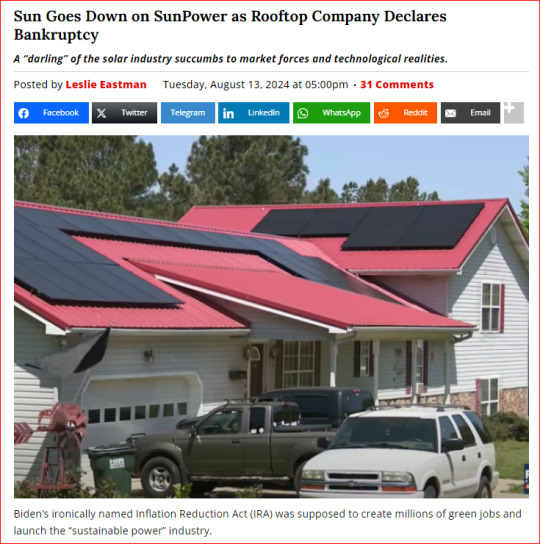

Biden’s ironically named Inflation Reduction Act (IRA) was supposed to create millions of green jobs and launch the “sustainable power” industry.
Subsidies flowed to support electric vehicles, wind farms, and solar energy. We have been covering the slowdown in the EV market, and residents of the East Coast are questioning all the promises made by the wind energy companies after the Vineyard Wind blade failure.
Now, it’s time to turn our attention to solar power. SunPower, the company that provides solar panels to many Californian homes in the sunny Coachella Valley area, filed for bankruptcy this week.
It is the latest development in a saga that has seen the company facing numerous serious and seemingly escalating challenges over the past several months, including allegations about executives’ misconduct related to the company’s financial statements and a recent decision that SunPower would no longer offer new solar leases. Days after the latter announcement, Coachella Valley-based Renova Energy, which markets and installs SunPower systems, said it was ending its partnership with SunPower and temporarily pausing operations after not receiving required payments from SunPower. SunPower’s executive chairman wrote in a letter posted on the company’s website on Monday that the company had reached an agreement to sell certain divisions of its business and suggested it was looking for one or more buyers to take on the rest, including the company’s responsibilities to maintain solar systems it has previously sold or leased.
It is important to note that SunPower was the industry’s “darling” to understand the magnitude of this development.
Founded in 1985 by a Stanford professor, SunPower was, for the past two decades, a darling of the solar industry. The company helped build America’s biggest solar plant, called Solar Star and located near Rosamond, California, and has installed solar panels on more than 100,000 homes. The company’s stock price has fluctuated dramatically, peaking during the solar stock frenzy of late 2007. As recently as January 2021, SunPower’s valuation momentarily reached $10 billion, buoyed by the expansion of its residential solar panels program. But since then, the company’s value has cratered — and this year, its situation became particularly dire.
It is also important to note that earlier this month, the bankruptcy of a solar-powered company in South Florida created an array of problems on the South Coast of California. Subcontractors are scrambling to find ways to guarantee payment for work on homes with equipment from the firm.
Meanwhile, homeowners are regretting their misplaced trust in eco-activists and city officials.
The business — Electriq Power Inc. — was putting solar panels and batteries on Santa Barbara rooftops at no expense to homeowners and with the blessings of the cities of Santa Barbara, Goleta, and Carpinteria. But then Electriq filed Chapter 7 on May 3, freezing all its operations. This prompted one of its subcontractors, Axiom 360 of Grover Beach, to place mechanics liens on homes for which it had yet to be paid. This preserves Axiom’s options for full payment of its installation work and is not unusual among contractors. But for homeowners who didn’t expect any financial outlay, it came as a shock, especially as the recording notice lists foreclosure in 90 days among the penalties. “You’re helping the environment. You’re not paying high rates to Southern California Edison,” said homeowner Randy Freed, explaining why he signed on to Electriq’s PoweredUp Goleta program. He was pleased with the savings in the solar array and storage batteries, but then he received the mechanics lien in June. The possibility of foreclosure was unanticipated, Freed said, and he’d relied on the cities’ endorsements. “It’s a great program; we’ve checked them out,” he recalled the cities saying on a postcard he received.
Hot Air's Beege Welborne takes an in-depth look at the cascade of warnings that indicate SunPower and the residential solar market are in serious trouble. She also hits on a point that is true for all green energy schemes: Today’s technology cannot keep up with the promises being made about tomorrow.
The technology side still hasn’t ironed itself out and may never with as saturated as the market is. With interest rates as high as they are and home prices through the roof, no one wants to pay a fortune for something that’s not rock solid. …That “sustainable” growth is only possible once all the artificial supports are knocked away and the technology proves viable and worth the cost once and for all.
Of course, the solar industry isn’t helped by the fact that the cost savings for customers aren’t quite as lavish as originally promised.
12 notes
·
View notes
Text

EnerPHit Standard for Home Energy Renovation
Nowadays, home energy renovation has become a pressing need in the context of sustainability and energy efficiency.
The EnerPHit Standard, developed by the Passive House Institute, offers a clear and rigorous framework for achieving buildings that not only meet comfort and livability criteria but are also highly energy efficient. This article explores the EnerPHit Standard, its fundamental principles, and the advantages it offers in the home energy renovation process.
Definition of the EnerPHit Standard
The EnerPHit Standard is a certification aimed at building renovation projects seeking to improve their energy performance. Unlike the Passive House Standard, which applies to new buildings, EnerPHit focuses on the renovation of existing structures. This framework establishes specific requirements in terms of insulation, airtightness, and indoor air quality, ensuring that renovated homes achieve a level of efficiency similar to that of a Passive House, while adapting to the unique characteristics of each older building. Principles of the EnerPHit Standard
1. Thermal Insulation: Significant improvements in insulation are required in walls, ceilings, and floors, reducing heat loss in winter and decreasing heat gain in summer.
2. Airtightness: Reducing air infiltration is crucial. Limits are established to ensure that cold or hot outside air does not compromise internal comfort.
3. Controlled Ventilation: The installation of mechanical ventilation systems with heat recovery is promoted, ensuring a constant supply of fresh air without losing stored energy.
4. Renewable Energy: Promotes the incorporation of renewable energy sources, such as solar panels, to reduce dependence on fossil fuels and reduce the carbon footprint.
5. Improved Comfort: Through careful design, optimal temperature and humidity levels are maintained, creating pleasant and healthy interior spaces.
Advantages of the EnerPHit Standard Adopting the EnerPHit standard in home renovations offers numerous advantages, both individually and collectively. Below, we highlight some of the most relevant:
1. Reduction in Energy Consumption
One of the main advantages of implementing the EnerPHit standard is the dramatic reduction in energy consumption in renovated homes. Thanks to significant improvements in insulation and airtightness, homeowners can experience a noticeable decrease in their energy bills. This not only saves money but also contributes to a lower demand for energy resources nationwide.
2. Increased Thermal Comfort
Homes that comply with the EnerPHit standard provide a much more comfortable indoor environment. The improved insulation and controlled ventilation ensure pleasant temperatures year-round, avoiding common problems such as cold drafts and excess humidity.
3. Added Value to the Property
Properties that are renovated according to the EnerPHit standard typically have a higher market value. Buyers are increasingly interested in energy-efficient homes, and renovations to this standard can be a decisive factor in a real estate transaction.
4. Contribution to Environmental Sustainability
The implementation of the EnerPHit standard plays a crucial role in the fight against climate change. By drastically reducing energy consumption and promoting the use of renewable energy, greenhouse gas emissions are reduced. This contributes not only to local sustainability but also to global climate change goals.
5. Improved Indoor Air Quality
The EnerPHit standard promotes ventilation systems that ensure a constant flow of fresh air, significantly improving indoor air quality. This is especially important for occupant health, as it reduces risks associated with indoor air pollution, such as respiratory problems and allergies.
6. Adaptability to Existing Buildings
EnerPHit has the advantage of being flexible, allowing a wide range of existing buildings to be renovated to its standards. This makes it a viable option for both individual homes and apartment buildings, adapting to diverse climatic conditions and architectural contexts.
7. Enhancing Community Participation
Renovating buildings to the EnerPHit standard can foster community cohesion. Renovation projects can engage local residents, promoting dialogue and collaboration among the various stakeholders. This not only improves community perceptions but can also result in an increased sense of belonging and local pride.
8. Economic and Financial Incentives
In many countries, there are subsidies and financial support programs aimed at encouraging the energy renovation of buildings. Adopting the EnerPHit standard can open the door to these financing opportunities, which can ease the financial burden of renovation work. Challenges in Implementing the EnerPHit Standard
Despite the numerous advantages of the EnerPHit standard, its implementation is not without challenges. Among the most notable are:
1. Initial Costs
The initial investment to renovate a building to the EnerPHit standard can be significant. Although the long-term energy cost savings are considerable, owners may be reluctant to make the necessary initial investment.
2. Structural Limitations
When working with existing buildings, structural limitations often arise that can complicate the full application of EnerPHit criteria. This requires detailed architectural analysis and, sometimes, creative solutions to meet the standards without compromising the building's integrity.
3. Lack of Awareness and Training
Lack of awareness and training about the EnerPHit standard among architects, engineers, and contractors can hinder its implementation. Providing adequate education and training is critical to ensure professionals understand how to properly apply the standard's principles.
4. Local Regulations
Sometimes, local building regulations may conflict with the requirements of the EnerPHit standard. It is essential that local authorities work to adapt regulations that facilitate the adoption of these standards in renovations.
5. Resistance to Change
A "business as usual" culture can be a significant obstacle. Many owners and professionals may still be skeptical about the real benefits of energy retrofitting, which can slow adoption efforts.
Conclusions
The EnerPHit standard represents an invaluable opportunity for residential energy retrofitting, offering a structured, evidence-based approach to improving the energy performance of existing buildings. The benefits of its implementation are numerous, from reduced energy consumption and increased thermal comfort to positive contributions to environmental sustainability. However, to maximize the potential of this standard, it is vital to address the challenges that arise during its implementation. Through education, adequate financing, and a collaborative approach among different stakeholders, it is possible to transform the vision of effective energy retrofitting into a reality accessible to all. In a world increasingly aware of the need for sustainability, the EnerPHit standard could be the path to a more efficient and environmentally friendly future.
#home#health and wellness#climate change#home decor#furniture#decor#saludybienestar#renewable energy#green energy#clean energy#good news#hope#global warming#climate anxiety#environment#ecology#fossil fuels#solar energy#wind energy#hydroelectric energy
3 notes
·
View notes
Text
Dandelion News - March 8-14
Like these weekly compilations? Tip me at $kaybarr1735 or check out my Dandelion Doodles!
1. Caribbean reef sharks rebound in Belize with shark fishers’ help

“Caribbean reef shark populations have rebounded beyond previous levels, more than tripling at both Turneffe and Lighthouse atolls[…. The recovery] arose from a remarkable synergy among shark fishers, marine scientists and management authorities[….]”
2. Landmark Ruling on Uncontacted Indigenous Peoples’ Rights Strikes at Oil Industry

“[T]he Ecuadorian government [must] ensure any future expansion or renewal of oil operations does not impact Indigenous peoples living in voluntary isolation. [… E]ffective measures must be adopted to prevent serious or irreversible damage, which in this case would be the contact of these isolated populations,” said the opinion[….]”
3. America's clean-energy industry is growing despite Trump's attacks. At least for now
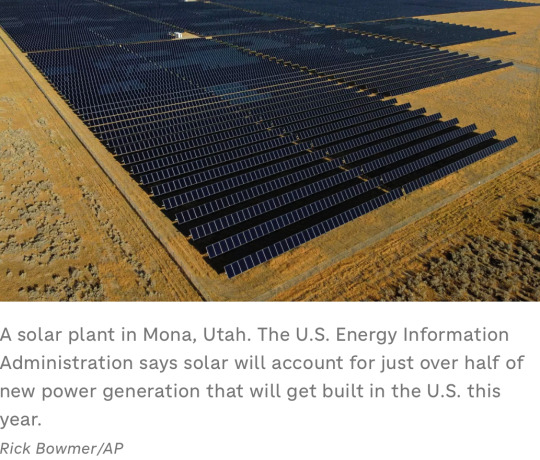
“The buildout of big solar and battery plants is expected to hit an all-time high in 2025, accounting for 81% of new power generation[….] The industry overall has boomed thanks to falling technology costs, federal tax incentives and state renewable-energy mandates.”
4. Study says endangered Asian elephant population in Cambodia is more robust than previously thought

“A genetic study of Asian elephants […] reveals a larger and more robust population than previously thought, raising hopes the endangered species could slowly recover. […] “With sufficient suitable habitat remaining in the region, the population has the potential to grow if properly protected,” the report concludes.”
5. Scientists are engineering a sense of touch for people who are paralyzed

“[Engineers are] testing a system that can restore both movement and sensation in a paralyzed hand. [… A]fter more than a year of therapy and spinal stimulation, [… h]is increased strength and mobility allow him to do things like pet his dog. And when he does, he says, "I can feel a little bit of the fur."“
6. Florida is now a solar superpower. Here’s how it happened.
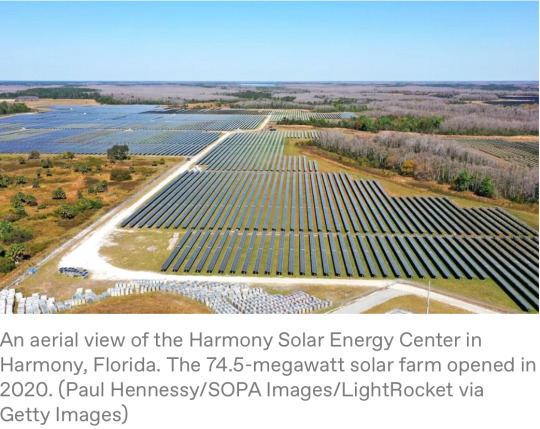
“In a first, Florida vaulted past California last year in terms of new utility-scale solar capacity plugged into its grid. It built 3 gigawatts of large-scale solar in 2024, making it second only to Texas. And in the residential solar sector, Florida continued its longtime leadership streak.”
7. Rare frog rediscovered after 130 years

“The researchers discovered two populations of the frog[….] "The rediscovery of A. vittatus allowed us to obtain, more than a century after its description, the first biological and ecological data on the species.” [… S]hedding light on where and how they live is the first step in protecting them.”
8. Community composting programs show promise in reducing household food waste

“The program [increased awareness and reduced household waste, and] also addressed common barriers to home composting, including pest concerns and technical challenges that had previously discouraged participants from composting independently.”
9. Pioneering Australian company marks new milestone on “mission” to upcycle end-of-life solar panels

“[…] SolarCrete – a pre-mixed concrete made using glass recovered from used solar panels – will form part of the feasibility study[….] A second stage would then focus on the extraction of high value materials[…] for re-use in PV and battery grade silicon, [… and] electrical appliances[….]”
10. Beavers Just Saved The Czech Government Big Bucks

“The aim was to build a dam to prevent sediment and acidic water from two nearby ponds from spilling over, but the project was delayed for years due to negotiations over land use[….] Not only did the industrious rodents complete the work faster than the humans had intended, they also doubled the size of the wetland area that was initially planned.”
March 1-7 news here | (all credit for images and written material can be found at the source linked; I don’t claim credit for anything but curating.)
#hopepunk#good news#shark#fishing#nature#ecuador#first nations#oil drilling#clean energy#solar energy#solar power#elephants#elephant#conservation#animals#science#medicine#paralyzed#florida#solar panels#frogs#endangered species#endangered#compost#community#australia#recycling#beaver#habitat restoration#beaver dam
146 notes
·
View notes
Text
Cost Breakdown of Different Patio Enclosure Materials
A patio enclosure is one of the best ways to transform an outdoor space into a comfortable, usable area year-round. But before jumping in, there's one big decision to make—what materials should you use?
Different materials affect the cost, durability, maintenance, and overall feel of your patio enclosure. Whether you want a budget-friendly screen enclosure, a durable vinyl structure, or a high-end glass sunroom, the right choice depends on your needs, climate, and budget.
This guide breaks down the costs, pros, and cons of different patio enclosure materials so you can choose the best option for your space.
How Much Does a Patio Enclosure Cost?
Before you start picking out materials or design ideas, it’s helpful to get a sense of the average cost of a patio enclosure, including both materials and installation. A basic screened-in patio is typically the most affordable option, ranging from $1,000 to $7,000. If you’re considering vinyl or acrylic panels, those enclosures usually cost between $3,000 and $12,000, depending on the size and features.
For a more upscale option, a glass sunroom can run anywhere from $10,000 to over $40,000. Meanwhile, retractable enclosures, which offer flexible indoor and outdoor use, generally fall within the $7,000 to $25,000 range. What drives the price up or down comes down to three things: the materials you choose, the labor required, and the level of customization in the final design.
Screen Materials: Budget-Friendly & Simple
A screened-in patio is one of the most affordable and practical enclosure choices, especially if you’re aiming for simplicity without sacrificing comfort. It’s perfect for keeping bugs out while still allowing fresh air to circulate, making it ideal for use in warm weather or for seasonal relaxation. When it comes to materials, fiberglass screens are typically the most budget-friendly, costing around $0.15 to $0.50 per square foot. They’re easy to install and resist corrosion, though they’re not as durable as metal options.
Aluminum screens, priced between $0.25 and $0.75 per square foot, offer better visibility and strength, but they can dent easily and may corrode over time. If you have pets, a pet-resistant mesh, ranging from $0.60 to $1.00 per square foot, can stand up to scratches and claws, though it does cost more.
Solar screens, which fall between $0.80 and $1.50 per square foot, are a smart pick for blocking heat and UV rays, though they do reduce airflow and visibility slightly. If you're after an enclosure that keeps pests at bay without breaking the bank, fiberglass or aluminum screens are both solid options.
Vinyl & Acrylic Panels: A Step Up from Screens
If you’re looking for more protection from the elements than a basic screen enclosure can offer—but without the high cost of a full glass setup—vinyl and acrylic panels are a smart middle-ground choice. Vinyl panels, which typically cost between $2 and $5 per square foot, are lightweight, flexible, and relatively affordable. They’re a good fit for casual seasonal use but may discolor or wear down over time.
On the other hand, acrylic panels range from $5 to $12 per square foot and offer better durability. They’re more resistant to cracking and provide a sturdier barrier against wind and rain, though they can scratch more easily and cost more upfront.
These panel options are ideal for homeowners who want enhanced weather protection without making the jump to a glass sunroom. If long-term durability is your priority, acrylic is the stronger choice—but if budget is top of mind, vinyl gets the job done without stretching your wallet.
Glass: The Ultimate Four-Season Enclosure
If you’re dreaming of a patio space that feels like part of your home no matter the season, a glass enclosure—or sunroom—is the way to go. It offers year-round comfort and adds significant value to your property. Glass enclosures come in different types depending on your needs and budget.
Single-pane glass, priced between $5 and $10 per square foot, offers clear views at a lower cost but lacks insulation, making it less ideal for colder months. Double-pane glass, which ranges from $10 to $25 per square foot, provides solid insulation and better energy efficiency—perfect for those who want a comfortable space without high heating or cooling bills. For top-tier performance, Low-E glass costs around $15 to $30 per square foot and helps block UV rays while minimizing heat loss. However, it requires a higher upfront investment and professional installation.
A glass sunroom is best suited for homeowners who want a fully enclosed, climate-controlled space that can be enjoyed throughout all four seasons. And if you’re in a colder area, spending a bit more on double-pane or Low-E glass can pay off in long-term comfort and energy savings.
Framing Materials: Structure & Support
The frame of your patio enclosure does more than just hold everything together—it affects how your space looks, how long it lasts, and how much upkeep it’ll need over the years. Each framing material has its pros and cons, and the right choice often depends on your priorities. Wood, costing around $3 to $10 per square foot, offers a classic, natural aesthetic and can be easily customized. However, it requires regular maintenance and is prone to warping or rot if not properly taken care of.
Aluminum, priced between $4 and $15 per square foot, is a popular pick thanks to its rust resistance, lightweight structure, and low maintenance needs. It can dent under pressure, but many homeowners in Lake County prefer it for its practicality and clean look.
Steel, while stronger and ideal for larger enclosures, is heavier, more expensive (around $10 to $20 per square foot), and may rust if not treated. Vinyl sits in the middle, at $5 to $12 per square foot, and offers a weather-resistant, low-maintenance option. However, it has fewer design options and can discolor over time. For most people, aluminum strikes the best balance between durability and upkeep—making it a go-to choice for long-lasting, hassle-free patio structures.
Retractable Enclosures: The Best of Both Worlds
A retractable enclosure allows you to open or close your patio on demand, making it one of the most flexible options available.
Retractable Enclosure Costs
Manual Retractable Screens – $500 - $5,000
Motorized Retractable Roofs – $7,000 - $25,000
Glass or Vinyl Retractable Walls – $10,000 - $35,000+
Best for: Homeowners who want the ability to open their patio in good weather but close it off during bad weather.
Motorized retractable enclosures are a luxury feature, but they provide the ultimate convenience and flexibility.
Final Thoughts
So, which material is best for your patio enclosure?
On a budget? → Fiberglass or aluminum screens
Want better weather protection? → Vinyl or acrylic panels
Looking for a true four-season room? → Double-pane or Low-E glass
Need a low-maintenance frame? → Aluminum or vinyl
Want flexibility? → Retractable enclosures
If you’re still unsure, Screenmobile can help you choose the perfect patio enclosure materials for your home and budget.
Ready to transform your patio? Contact Screenmobile of Michiana Shores, MI, today for a free quote!
2 notes
·
View notes
Text
Can I install solar panels on asphalt shingles?
Did you know that installing solar panels on your asphalt shingle roof can significantly reduce your energy bills and increase your home's value? It's true! However, ensuring that both your roofing and solar installations are done correctly is essential for long-term durability and safety. This begins with selecting a reliable asphalt roofing contractor who can seamlessly integrate solar panels into your existing roof structure.
Choosing the right contractor isn't just about getting the job done; it's about ensuring the longevity and performance of your roof and solar system. A well-executed installation enhances curb appeal, provides robust protection against the elements, and supports the efficiency of your solar panels. Conversely, a subpar job can lead to leaks, structural issues, and costly repairs down the line.
The good news is that finding a trustworthy asphalt roofing contractor doesn't have to be stressful. With the right guidance and a systematic approach, you can make an informed decision that sets your roofing project up for success. In this article, we'll walk you through practical steps to evaluate potential contractors, understand key considerations, and ultimately choose a professional who meets your needs.
Understanding the Compatibility of Solar Panels and Asphalt Shingles
Before diving into the process of hiring a contractor, it's important to understand that asphalt shingle roofs are well-suited for solar panel installations. Their durability and widespread use make them a common choice for homeowners considering solar energy.
Steps to Find a Reliable Asphalt Roofing Contractor
To ensure a successful roofing project, consider the following steps when selecting a contractor:
1. Verify Licenses and Insurance
Licensing: Ensure the contractor holds the necessary licenses to perform roofing work in your area. This demonstrates their compliance with local regulations and standards.
Insurance: Confirm that the contractor has both liability insurance and workers' compensation coverage. This protects you from potential liabilities in case of accidents or damages during the project.
2. Evaluate Experience with Asphalt Roofing
Specialization: Look for contractors who specialize in asphalt shingle roofing, as they will be more familiar with the specific techniques and challenges associated with this material.
Years in Business: Consider how long the contractor has been in operation. A longer track record can indicate reliability and quality workmanship.
3. Review Portfolios and References
Previous Work: Ask to see a portfolio of completed projects similar to yours. This will give you insight into the quality and style of their work.
References: Request contact information for past clients and follow up with them to inquire about their experience with the contractor, including punctuality, communication, and satisfaction with the finished product.
4. Understand Warranties and Guarantees
Workmanship Warranty: Inquire about the warranty provided on the installation work. A reputable contractor should offer a warranty that covers their labor for a reasonable period.
Manufacturer's Warranty: Ensure that the materials used come with a manufacturer's warranty and that the contractor is certified to install those products, as improper installation can void the warranty.
5. Compare Written Estimates
Detailed Quotes: Obtain written estimates from multiple contractors. Each quote should be detailed, outlining the cost of materials, labor, and any additional fees.
Value Over Price: While it's tempting to choose the lowest bid, consider the value offered. A higher price may be justified by better materials, longer warranties, or superior workmanship.
6. Assess Communication and Professionalism
Responsiveness: Pay attention to how promptly and clearly the contractor communicates. This reflects their professionalism and reliability.
Written Contract: Ensure all aspects of the project are documented in a written contract, including timelines, payment schedules, and the scope of work.
Key Questions to Ask During Consultations
When meeting with potential contractors, consider asking the following questions:
What is your experience with installing asphalt shingle roofs, particularly those integrated with solar panels?
Can you provide references from recent clients who had similar projects?
What warranties do you offer on both materials and workmanship?
How do you handle unforeseen issues that may arise during the project, such as hidden structural damage?
What measures do you take to ensure the safety of your crew and my property during the installation?
Final Thoughts
A roofing project that involves installing solar panels on asphalt shingles is a significant investment in your home's future. By taking the time to research and select a reliable asphalt roofing contractor, you're ensuring that your roof will be both functional and aesthetically pleasing for years to come.
Remember, the goal is to find a contractor who not only meets technical qualifications but also aligns with your expectations and communicates effectively. Trust your instincts, do your due diligence, and don't hesitate to ask questions throughout the process.
With careful consideration and the right professional by your side, you'll be well on your way to enhancing your home's value, protection, and energy efficiency.
2 notes
·
View notes
Text
Heating Contractor Solutions for Eco-Friendly Heating Options
Introduction
As the world shifts towards more sustainable living practices, homeowners and businesses alike are in search of eco-friendly heating solutions. The demand for energy-efficient systems has led to an evolution in the HVAC industry, pushing heating contractors to innovate and adapt. This article dives deep into various eco-friendly heating options available today, emphasizing the role of HVAC contractors, air conditioning contractors, and other relevant professionals in ensuring optimal comfort while minimizing environmental impact.
Heating Contractor Solutions for Eco-Friendly Heating Options
Heating contractor solutions encompass a broad range of services focused on providing efficient heating systems that are both effective and environmentally friendly. From installation to maintenance, these experts are pivotal in guiding property owners toward greener alternatives.
Understanding Eco-Friendly Heating Systems
What exactly qualifies as an eco-friendly heating system? At its core, such a system minimizes carbon footprint while maximizing energy efficiency. Common examples include:
youtube
Heat Pumps: These systems transfer heat rather than generating it directly, making them highly efficient. Solar Thermal Systems: Utilizing solar panels to capture sunlight for heating water or air. Biomass Boilers: Using organic materials like wood pellets for combustion.
Each of these systems has its unique benefits and challenges.
youtube
The Role of HVAC Contractors in Eco-Friendly Solutions
HVAC contractors play a critical role in installing and maintaining eco-friendly systems. They assess your home’s specific needs and recommend the best options based on size, insulation quality, local climate conditions, and budget.
Consultation Services: HVAC contractors can provide insights into which eco-friendly options would work best for your home. Installation Expertise: Proper installation is crucial for efficiency; qualified HVAC professionals ensure that your system operates optimally from day one. Regular Maintenance: Like any mechanical system, eco-friendly heaters require routine check-ups to maintain peak performance. Air Conditioning Contractors and Their Influence
Air conditioning contractors also contribute significantly to eco-friendly solutions by integrating energy-efficient cooling methods with heating technology. For instance:
Installing high SEER-rated AC units reduces energy consumption. Implementing smart thermostats allows better control over temperatures. Benefits of Eco-Friendly Heating Options Cost Savings on Energy Bills
One of the most appealing aspects of eco-friendly heating options is their potential to lower monthly utility bills significantly. Systems like heat pumps can reduce electricity Air conditioning contractor usage by up to 50%, leading to substantial savings over time.
Increased Property Value
Investing in green technology often yields higher property values. Homebuyers are increasingly seeking homes equipped with energy-efficient features — this trend adds value to properties that prioritize sustainability.
2 notes
·
View notes
Text
The Benefits of Residential Solar Solutions in Australia
With the rising costs of electricity and growing concerns about environmental sustainability, more Australian homeowners are turning to solar energy. Devam Solar Australia, with over seven years of experience in solar panel fitting, maintenance, and supply, is committed to providing high-quality Devam Solar Residential Solutions. If you’re considering switching to solar energy, here are some key benefits to keep in mind.

1. Significant Cost Savings
One of the biggest advantages of installing a solar system is the reduction in electricity bills. By generating your own energy, you can cut down on grid dependency and save thousands of dollars in the long run. Additionally, Australia offers various incentives, rebates, and feed-in tariffs that allow homeowners to earn credits for excess energy sent back to the grid.
2. Sustainable and Eco-Friendly
Solar energy is a renewable and clean source of power, reducing your household’s carbon footprint. Unlike fossil fuels, solar panels produce energy without emitting greenhouse gases, making it a great choice for environmentally conscious homeowners. By switching to solar, you contribute to a greener future for Australia.
3. Increase in Property Value
Homes with solar panel installations are in high demand. Many buyers are willing to pay a premium for energy-efficient properties. A solar system not only enhances your home’s value but also makes it more attractive in the competitive real estate market.
4. Energy Independence and Security
With solar power, you can generate your own electricity and reduce reliance on external power sources. This is particularly beneficial in areas with frequent power outages or fluctuating energy prices. Installing a battery storage system allows you to store excess energy for use during nighttime or cloudy days, ensuring an uninterrupted power supply. Devam Solar's Reliable Batteries ensure that you have a consistent and efficient power backup.
5. Low Maintenance Costs
Residential solar systems require minimal maintenance, making them a cost-effective energy solution. Devam Solar provides professional installation and ongoing maintenance services to ensure the efficiency and longevity of your system. With periodic cleaning and occasional check-ups, solar panels can last for over 25 years. Devam Solar Comprehensive Services cover everything from installation to maintenance, ensuring seamless energy solutions for your home.
6. Government Incentives and Rebates
The Australian government offers financial incentives to encourage homeowners to install solar panels. Programs like the Small-scale Renewable Energy Scheme (SRES) provide rebates that significantly reduce the upfront cost of solar system installation. Additionally, state-based incentives further enhance affordability, making Affordable Solar Solutions Victoria a reality for many homeowners.
7. Support for a Sustainable Future
By switching to solar power, you play a crucial role in Australia’s transition towards renewable energy. Investing in solar solutions contributes to reducing the demand for non-renewable energy sources, promoting a cleaner and more sustainable environment for future generations. NetCC Solar Solutions in Victoria provides advanced solar technologies that enhance energy efficiency and sustainability.
Why Choose Devam Solar?
With over seven years of expertise in the Australian solar industry, Devam Solar specializes in high-quality Devam Solar Residential Solutions and Devam Solar Commercial Solutions. Our team is dedicated to delivering efficient and reliable solar solutions tailored to meet your specific energy needs. Whether you’re looking to reduce electricity costs, enhance property value, or contribute to a greener planet, we have the right solution for you.
We also offer Solar Batteries & Heat Pump Services Australia, ensuring that you get the best power storage solutions for your needs. As part of devam group, we integrate innovative technologies to deliver the best solar energy solutions, including NetCC Solar Solutions and Commercial Solar Solutions.
Make the smart switch today! Contact Devam Solar to learn more about our Devam Solar Residential Solutions and take the first step towards energy independence with our Affordable Solar Solutions Victoria.
#Solar#Solar Solutions#Solar Australia#Solar Panels#Residential Solar#Home Solar#Devam Solar#Devam Solar Australia#Devam Solar Residential Solutions#Power Your Business With Devam Solar#Devam Solar Commercial Solutions#Devam Solar Comprehensive Services#Devam Solars Reliable Batteries#Solar Batteries & Heat Pump Services#devam group#Netcc Solar Solutions#Affordable Solar Solutions Victoria#Solar Batteries & Heat Pump Services Australia#devam technologies#Solar Batteries & Heat Pump Services Victoria#affordable solar solutions#NetCC Solar Solutions in Victoria#Commercial Solar Solutions
3 notes
·
View notes